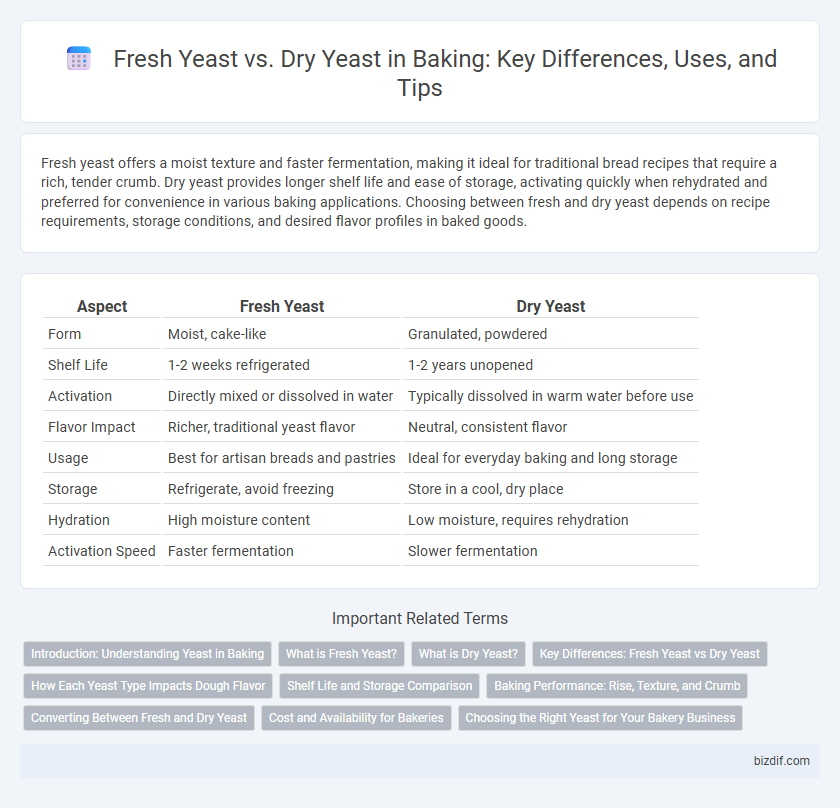Fresh yeast offers a moist texture and faster fermentation, making it ideal for traditional bread recipes that require a rich, tender crumb. Dry yeast provides longer shelf life and ease of storage, activating quickly when rehydrated and preferred for convenience in various baking applications. Choosing between fresh and dry yeast depends on recipe requirements, storage conditions, and desired flavor profiles in baked goods.
Table of Comparison
| Aspect | Fresh Yeast | Dry Yeast |
|---|---|---|
| Form | Moist, cake-like | Granulated, powdered |
| Shelf Life | 1-2 weeks refrigerated | 1-2 years unopened |
| Activation | Directly mixed or dissolved in water | Typically dissolved in warm water before use |
| Flavor Impact | Richer, traditional yeast flavor | Neutral, consistent flavor |
| Usage | Best for artisan breads and pastries | Ideal for everyday baking and long storage |
| Storage | Refrigerate, avoid freezing | Store in a cool, dry place |
| Hydration | High moisture content | Low moisture, requires rehydration |
| Activation Speed | Faster fermentation | Slower fermentation |
Introduction: Understanding Yeast in Baking
Yeast is a vital leavening agent in baking, responsible for fermentation that produces carbon dioxide, which helps dough rise. Fresh yeast, also known as cake or compressed yeast, contains live yeast cells with high moisture content, offering quick fermentation but a shorter shelf life. Dry yeast, including active dry and instant varieties, is dehydrated for longer storage and requires activation before use, making it convenient for extended baking projects.
What is Fresh Yeast?
Fresh yeast, also known as cake or compressed yeast, is a live yeast product with high moisture content, typically around 70%. It is favored in artisanal baking for its strong fermentation power and quick activation, resulting in superior dough rise and flavor development. Unlike dry yeast, fresh yeast requires refrigeration and has a shorter shelf life, making it ideal for professional bakers prioritizing quality and freshness.
What is Dry Yeast?
Dry yeast is a dehydrated form of yeast commonly used in baking to leaven bread and other baked goods. It consists of dormant yeast cells that activate when mixed with warm water, making it convenient for long-term storage and consistent fermentation. This yeast variety offers a longer shelf life compared to fresh yeast and is favored for its ease of use and reliable rising performance.
Key Differences: Fresh Yeast vs Dry Yeast
Fresh yeast contains higher moisture content, making it more perishable and requiring refrigeration, whereas dry yeast has a longer shelf life due to its dehydrated form and can be stored at room temperature. Fresh yeast activates more quickly in dough, providing a faster rise time, while dry yeast needs to be rehydrated or proofed before use, which can extend preparation time. Bakers often choose fresh yeast for rich, delicate pastries and dry yeast for convenience and consistent results in bread production.
How Each Yeast Type Impacts Dough Flavor
Fresh yeast imparts a rich, slightly sweet, and complex flavor to dough due to its high moisture content and active fermentation process. Dry yeast offers a more neutral taste, allowing other ingredients to shine while providing consistent and reliable leavening. The choice between fresh and dry yeast significantly influences the final bread's aroma and texture through differences in fermentation speed and yeast vitality.
Shelf Life and Storage Comparison
Fresh yeast, known for its high moisture content, has a significantly shorter shelf life of about 2 weeks when refrigerated at 2-4degC, requiring careful storage in airtight containers to maintain its viability. Dry yeast, by contrast, has a much longer shelf life ranging from 1 to 2 years due to its low moisture content and is best stored in a cool, dry place, with refrigeration further extending its longevity. The moisture level in fresh yeast makes it more perishable and sensitive to temperature fluctuations, while dry yeast's stability and ease of storage make it a preferred choice for long-term use in bakery operations.
Baking Performance: Rise, Texture, and Crumb
Fresh yeast offers superior baking performance with a faster rise, resulting in a lighter texture and more open crumb structure due to its high moisture content and active yeast cells. Dry yeast, while more shelf-stable, usually produces a slightly longer fermentation time, yielding a denser texture and a finer, more uniform crumb. Both types influence dough elasticity and gas retention, but fresh yeast is often preferred for artisanal breads requiring a soft, airy crumb.
Converting Between Fresh and Dry Yeast
Converting between fresh yeast and dry yeast requires adjusting quantities since fresh yeast contains about 70% moisture while dry yeast is dehydrated and more concentrated. The standard conversion ratio is approximately 3:1, meaning three parts fresh yeast equal one part dry yeast by weight to maintain consistent leavening power. Bakers should also adjust hydration levels in dough recipes to account for the moisture difference when substituting one form for the other.
Cost and Availability for Bakeries
Fresh yeast offers a lower upfront cost but has a shorter shelf life, requiring frequent purchases which can increase overall expenses for bakeries. Dry yeast, while slightly more expensive per unit, provides longer storage stability and easier transportation, reducing waste and ensuring consistent supply. Availability of dry yeast is generally higher globally, making it a more reliable choice for bakeries with varying production schedules.
Choosing the Right Yeast for Your Bakery Business
Fresh yeast offers a higher moisture content and faster fermentation, making it ideal for artisan bread with a soft crumb and rich flavor. Dry yeast, including active dry and instant varieties, provides longer shelf life and easier storage, perfect for scaling production in commercial bakeries. Selecting the right yeast depends on your bakery's production volume, desired bread characteristics, and storage capabilities to maximize efficiency and product quality.
Fresh yeast vs Dry yeast Infographic

 bizdif.com
bizdif.com